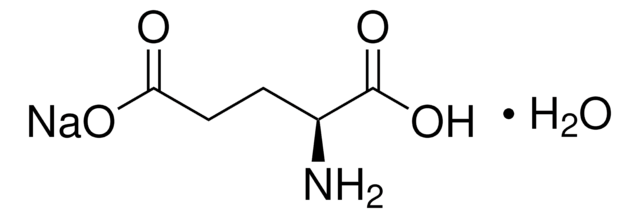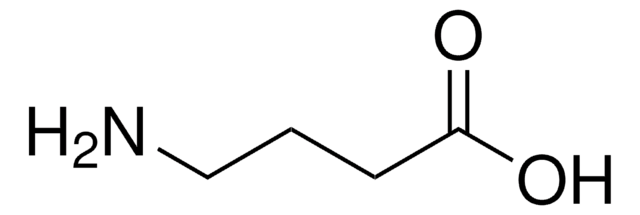W328502
L-Glutamic acid
FCC
Sinônimo(s):
(S)-2-Aminopentanedioic acid, Glu
About This Item
Produtos recomendados
fonte biológica
corn
Nível de qualidade
grau
Kosher
conformidade reg.
FCC
FDA 21 CFR 172.320
FDA 21 CFR 182.1045
Ensaio
98.5-101.5% dry basis (perchloric acid titration)
Formulário
powder or crystals
atividade óptica
[α]20/D +32°, c = 10 in 2 M HCl
pf
205 °C (dec.) (lit.)
solubilidade
water: soluble 8.64 g/L at 25 °C
densidade
1.54 g/cm3 at 20 °C
traços de cátion
As: ≤3 ppm
Cd: ≤1 ppm
Hg: ≤1 ppm
Pb: ≤5 ppm
aplicação(ões)
flavors and fragrances
alérgeno alimentar
no known allergens
Organoléptico
baked
cadeia de caracteres SMILES
N[C@@H](CCC(O)=O)C(O)=O
InChI
1S/C5H9NO4/c6-3(5(9)10)1-2-4(7)8/h3H,1-2,6H2,(H,7,8)(H,9,10)/t3-/m0/s1
chave InChI
WHUUTDBJXJRKMK-VKHMYHEASA-N
Informações sobre genes
human ... CCR2(1231) , GRIA1(2890) , GRIA2(2891) , GRIA4(2893) , GRIK1(2897) , GRIK2(2898) , GRIK3(2899) , GRIK5(2901) , GRIN2B(2904) , GRM2(2912) , SLC1A1(6505) , SLC1A2(6506)
rat ... Gria1(50592) , Grik1(29559) , Grik2(54257) , Grik4(24406) , Grin2a(24409) , Grm1(24414) , Grm2(24415) , Grm3(24416) , Grm4(24417) , Grm5(24418) , Grm6(24419) , Grm7(81672) , Slc1a2(29482)
Procurando produtos similares? Visita Guia de comparação de produtos
Categorias relacionadas
Descrição geral
Ações bioquímicas/fisiológicas
Exoneração de responsabilidade
Aplicação
Código de classe de armazenamento
11 - Combustible Solids
Classe de risco de água (WGK)
WGK 1
Ponto de fulgor (°F)
Not applicable
Ponto de fulgor (°C)
Not applicable
Equipamento de proteção individual
Eyeshields, Gloves, type N95 (US)
Escolha uma das versões mais recentes:
Já possui este produto?
Encontre a documentação dos produtos que você adquiriu recentemente na biblioteca de documentos.
Os clientes também visualizaram
Chromatograms
application for HPLCGlobal Trade Item Number
| SKU | GTIN |
|---|---|
| W328502-25KG | |
| W328502-25KG-K | 4061834405856 |
| W328502-SAMPLE-K | 4061837528781 |
| W328502-10KG | |
| W328502-10KG-K | 4061835566891 |
| W328502-1KG-K | 4061835566907 |
| W328502-1KG | |
| W328502-5KG | |
| W328502-5KG-K | 4061837528774 |
| W328502-SAMPLE |
Nossa equipe de cientistas tem experiência em todas as áreas de pesquisa, incluindo Life Sciences, ciência de materiais, síntese química, cromatografia, química analítica e muitas outras.
Entre em contato com a assistência técnica





